Simultaneous Determination of 50 Elements in Geochemical Samples by Low-Pressure Closed Digestion-ICP-MS
Geochemical samples were digested using polytetrafluoroethylene (PTFE) crucibles with screw caps followed by ICP-MS analysis of 50 elements. Two-point standard curves were plotted using blank solution and national standard reference GSD-9 for stream sediments, and the acid system, digestion conditions, isotopes, and internal standards for each element were optimized. The results showed that the detection limits for most elements were less than 0.2 μg/g, and the relative standard deviations for all elements ranged from 1.1% to 16.4%. The measured values were in agreement with the certified values of national standard references. This method not only significantly reduces the amount of acid used and avoids dust contamination, but also accurately determines some volatile elements. In addition, it has the advantages of easy operation and high pretreatment efficiency, making it very suitable for laboratories with large numbers of samples and multiple elements to be tested.
Geochemical methods are considered to be the most effective technique for rapid exploration and evaluation of mineral resources, and it is also widely used in the field of environmental assessment (1–5). Geochemical methods requires large-scale sample analysis testing, with samples containing multiple elements and exhibiting a wide range of element concentrations and complex properties (6,7).
Elemental analysis of geochemical samples is commonly performed using techniques such as X-ray fluorescence (XRF) spectroscopy, inductively coupled plasma-optical emission spectroscopy (ICP-OES), inductively coupled plasma–mass spectrometry (ICP-MS), atomic absorption spectroscopy (AAS), and atomic fluorescence spectroscopy (AFS) (8–12). Of these, the first three are more commonly used because of their ability to analyze multiple elements simultaneously. Pretreatment methods for geochemical samples include acid digestion methods such as open digestion (13,14), high-pressure digestion (15), microwave digestion (16-18), and fusion methods (9,19–21). Based on the characteristics of geochemical samples, acid digestion combined with ICP-MS is particularly suitable for elemental analysis of geochemical samples—it has low detection limits, a wide linear range, and can analyze elements from ppt to ppm levels (22–24). In addition, it can determine multiple elements simultaneously, has strong anti-interference ability, and the prepared solution has a low salt content (25,26), making it ideal for large-scale analysis.
In acid digestion, there are advantages and disadvantages of high-pressure digestion, open digestion, and microwave digestion. High-pressure digestion can achieve complete digestion and can analyze refractory metals such as Zr and Hf, but the digestion time is long (27), and the accompanying heavy and cumbersome steel sleeves reduce work efficiency. In addition, the steel sleeves are easily corroded, which may contaminate elements such as Fe, Cr, Ni, and V. Open digestion is more commonly used due to its fast digestion and low equipment requirements, but it consumes a large amount of acid, and the sample is more likely to be contaminated by dust (28). Microwave digestion has the advantages of complete and fast digestion, but due to the limited number of pores of the microwave digestion instrument, it is difficult to deal with a large number of samples (29).
In this study, we combined the advantages of high-pressure closed digestion and open digestion by using polytetrafluoroethylene (PTFE) crucibles with screw caps for digestion. After the lid is tightly closed, there is a certain pressure inside the crucible, which prevents acid from escaping. Compared with the open digestion system, this method can greatly reduce the amount of acid used and avoid dust pollution. The qualification rate of some elements prone to contamination, such as Zn, Cr, and Cu, can be higher, and some volatile elements can also be accurately measured. Compared with the closed digestion tank with steel sleeve, the PTFE crucible has three advantages. First, it can effectively prevent the contamination of Fe, Cr, Ni, V and other elements caused by the steel sleeve. Second, it’s easy to operate. Third, the digestion tank is smaller, so more samples can be placed on the heating plate, greatly improving the efficiency of sample pretreatment.
Materials and Methods
Main Instruments
We used an ICAP-Q inductively coupled plasma mass spectrometer (Thermo); heating plate (LabTech Co.), and a polytetrafluoroethylene crucible with screw cap.
The instrument was calibrated using tuning solution to adjust sensitivity (cps), relative standard deviation (RSD, %), oxide yield (%), double charge yield (%), peak shape, and resolution to achieve higher precision values, as well as to select the optimal working conditions for the instrument.
The instrument conditions selected for optimal performance were as follows: The incident power was set to 1550 W, the nebulizer gas flow rate was set to 1.03 L/min, the cooling gas flow rate was set to 14.0 L/min, the auxiliary gas flow rate was set to 0.8 L/min, and the sampling depth was set to 150 mm.
Essential Reagents and Materials
National standard references for soils and stream sediments, including GBW07306(GSD-6), GBW07363(GSD-20), GBW07366(GSD-23), GBW07425(GSS-11), GBW07448(GSS-19), GBW07453(GSS-24), and GBW07309(GSD-9), have been developed by the Institute of Geophysical and Geochemical Exploration of the Chinese Academy of Geological Sciences.
We used 103Rh and 187Re single element internal standard stock solutions (Thermo Fisher Scientific); 1,000 μg/mL. They were turned into a mixed internal standard solution containing 10 ng/mL of 103Rh and 187Re, prepared by diluting the single-element internal standard stock solutions of 103Rh and 187Re stepwise with 3% (v/v) HNO3 as medium.
All reagents including HNO3, HF, H2SO4, HClO4 are metal oxide semiconductor (MOS) grade and have been purified by double-bottle subboiling distillation. The experimental water used is ultrapure water with a resistivity of at least 18 MΩ·cm.
Experimental Method
We weighed 0.1000 g of the sample, and put it into a PTFE crucible with screw cap. We then added 1 mL of HNO3, 3 mL of HF, and 0.4 mL H2SO4 into the crucible, mixed them well, and heated at 180 oC on a heating plate for 3 h. We then opened the cap and heated the contents at 180o to remove excess acid. When the acid solution had dried up, we turned off the heating plate, added 5 mL of 15–20 wt% nitric acid, and tightened the cap. After heating the crucibles on the residual heat of the heating plate for about 1 h, the solution was transfered to a 25 mL colorimetric tube and diluted to volume with pure water. The solution was then diluted 10 times and measured. A blank was prepared at the same time as the sample.
Using the blank solution as the low point and the national standard reference GSD-9 for stream sediments prepared simultaneously with the sample as the high point, the two-point standard working curve for each element was obtained by instrumental analysis. The internal standard mixture solution was added via a three-way valve, and the measurement was performed under the selected instrument working conditions.
Results
Standard Working Curve
Some scientists use national standard references instead of standard solutions to draw standard curves (30), which has the following advantages over the latter: (1) the results can be read directly, avoiding data conversion; (2) avoiding the complex preparation and measurement steps of standard solution series; (3) matrix effect can affect the accuracy of the determination of the results. For example, major elements such as Fe, Mg, Ca, and Al will seriously suppress Nb, Ta, La, Ce, and other elements (31), compared with using a multi-element mixed standard solution to plot the curve, using national standard reference that is closer to the matrix of the tested sample to plot the curve can effectively reduce the interference caused by matrix effect; (4) it is convenient to redraw the standard curve when the instrument signal drifts. Therefore, in this study, the national standard reference GSD-9 for stream sediments was used as the high point and the process blank as the low point to plot the standard curve.
Acid System
The acid system can have a significant effect on digestion efficiency. Three different acid systems were tested for the digestion of the national standard reference GSD-20: the first acid system contained 1 mL HNO3, 3 mL HF and 0.4 mL H2SO4, and the redissolving acid contained 5 mL HNO3; the second acid system contained 1 mL HNO3 and 3 mL HF, and the redissolving acid contained 5 mL HNO3; the third acid system contained 1 mL HNO3, 3 mL HF, and 0.4 mL H2SO4, and the redissolving acid contained 5 mL aqua regia.
Based on the digestion effect, only a small amount of residue remained in the digestion crucibles when using a mixed acid of 1 mL HNO3 + 3 mL HF, while the solution became clear and transparent when using a mixed acid of 1 mL HNO3 + 3 mL HF + 0.4 mL H2SO4. Further analysis of the test elements with the instrument showed that the results for most elements were relatively accurate in all three systems. However, there were significant differences in the results of elements such as As, Sc, Se, Ta, V, and Y compared to the certified values, as shown in Table I (all tables accessible through the QR code at the end of the article). The results indicated that the limited digestion capability of the HNO3 + HF system resulted in incomplete digestion of some geological samples, leading to inaccurate results for the above elements when H2SO4 was not added during digestion. The use of aqua regia for redissolution caused significant deviations for As, Se, Ta, and V, and even resulted in no signal for Ag, which was attributed to Cl- interference (32). For Ta, it is possible that Cl- interferes with its determination, or that Cl- accelerates its hydrolysis. Therefore, in this study, a mixed acid of HNO3 + HF + H2SO4 was selected for digestion and HNO3 was used for redissolving acid.
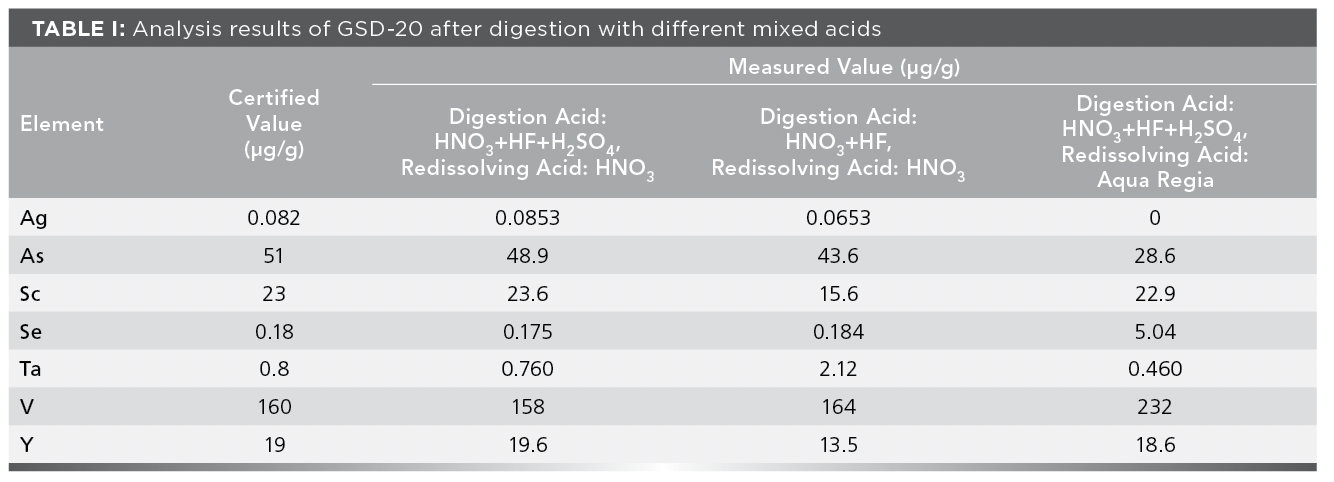
Regarding acid addition, HNO3 and HF evaporate easily and have little effect on pretreatment efficiency. H2SO4 is a high boiling point acid that can improve the digestion of geological samples. However, due to its high viscosity and boiling point, the addition of H2SO4 to the digestion process takes a considerable amount of time. Therefore, the amount of H2SO4 should be minimized to improve the digestion efficiency while ensuring the digestion effect. As representative elements, As, Sc, Se, Ta, V, and Y were selected, and the spike recoveries of these elements were tested with H2SO4 addition amounts of 0.1, 0.2, 0.3, 0.4, and 0.5 mL while keeping other conditions constant. The results are shown in Figure 1. As shown in Figure 1, when the amount of H2SO4 added is less than 0.3 mL, the spike recoveries of the five elements other than Sc all decrease to varying degrees. Finally, the amount of H2SO4 added in this method was 0.4 mL.
FIGURE 1: Relationship between spiked recoveries of each element and amount of H2SO4.
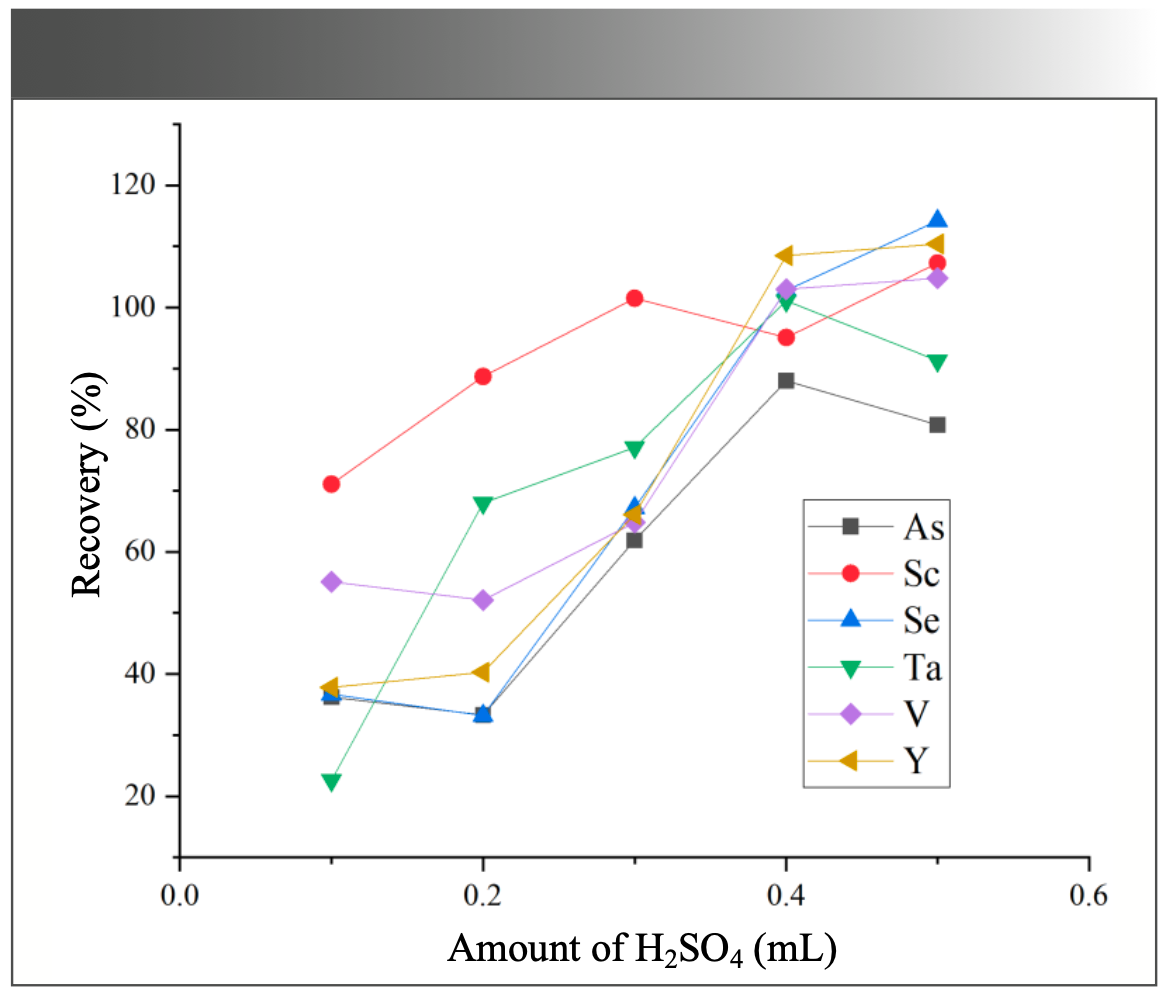
Digestion Conditions
GSD-20 was selected as the test sample for the digestion test, while other experimental conditions were kept constant in terms of digestion time. The digestion time was set to 1 h, 2 h, 3 h, and 4 h. Taking Sc, Ga, Y, La, and Ce as representatives, their spike recovery with respect to digestion time is shown in Figure 2. As shown in Figure 2, the sample cannot be completely digested within 1–2 h, while accurate results can be obtained with a digestion time of 3 h or more. Therefore, the digestion time was set at 3 h. After digestion, the acid can be removed during the night without affecting the next day’s work, which is also more suitable for batch testing. As for the digestion temperature, it should not be too high or too low. A high temperature may damage the digestion crucible or cause acid leakage due to excessive pressure inside the digestion crucible, which may affect the digestion efficiency. In addition, a high temperature may cause the loss of some volatile elements such as Se, Te, Ge, and As during the acid removal process. A low temperature results in slow digestion, especially when H2SO4 is added, which reduces the digestion efficiency. Finally, the digestion conditions were set at 180o for 3 h.
FIGURE 2: Relationship between the spiked recoveries and digestion time.
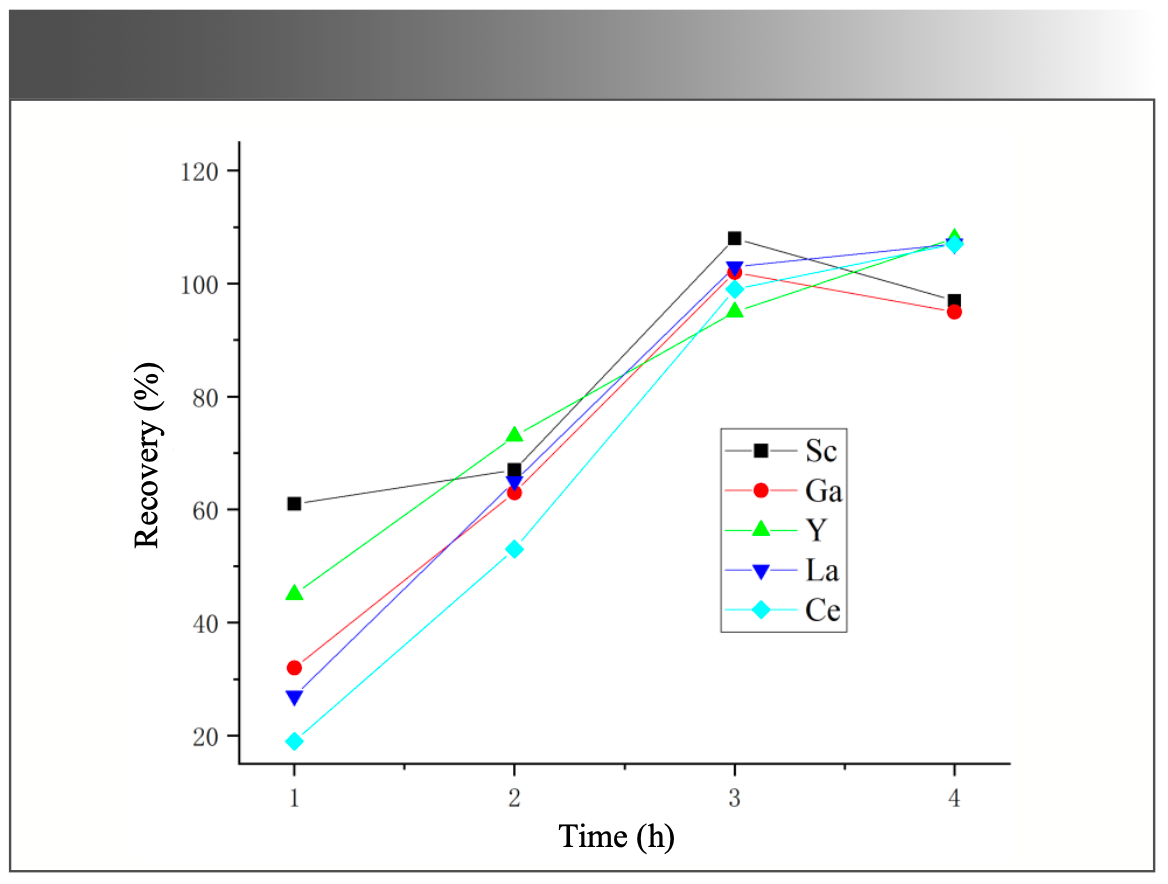
Isotopes and Internal Standard Elements
In principle, isotopes with high abundance and low interference should be selected for analysis. Based on this principle and the actual measurement results of the elements to be tested, the isotopes selected for analysis are 7Li, 9Be, 41P, 45Sc, 48Ti, 51V, 52Cr, 55Mn, 59Co, 60Ni, 63Cu, 66Zn, 71Ga, 73Ge, 75As, 77Se, 85Rb, 88Sr, 89Y, 93Nb, 95Mo, 107Ag, 111Cd, 115In, 118Sn, 121Sb, 125Te, 133Cs, 137Ba, 139La, 140Ce, 141Pr, 146Nd, 147Sm, 153Eu, 157Gd, 159Tb, 163Dy, 165Ho, 166Er, 169Tm, 172Yb, 175Lu, 181Ta, 182W, 205Tl, 208Pb, 209Bi, 232Th, and 238U. By selecting appropriate internal standard elements, the interference caused by the matrix effect can be compensated and the drift of the analytical signal can be effectively monitored and corrected. Since there are many elements to be tested, elements with mass number less than 139 (Li-Ba) are uniformly assigned Rh as the internal standard, while elements with mass number greater than 139 (La-U) are uniformly assigned Re as the internal standard. To minimize the effect of instrument signal drift, the standard curve can be replotted every 20 samples.
Method Detection Limit
According to the experimental procedure, a two-point standard curve was plotted and the blank solution was continuously measured 12 times throughout the process. The detection limit was calculated using the threefold standard deviation method of the measurement results, as shown in Table II.
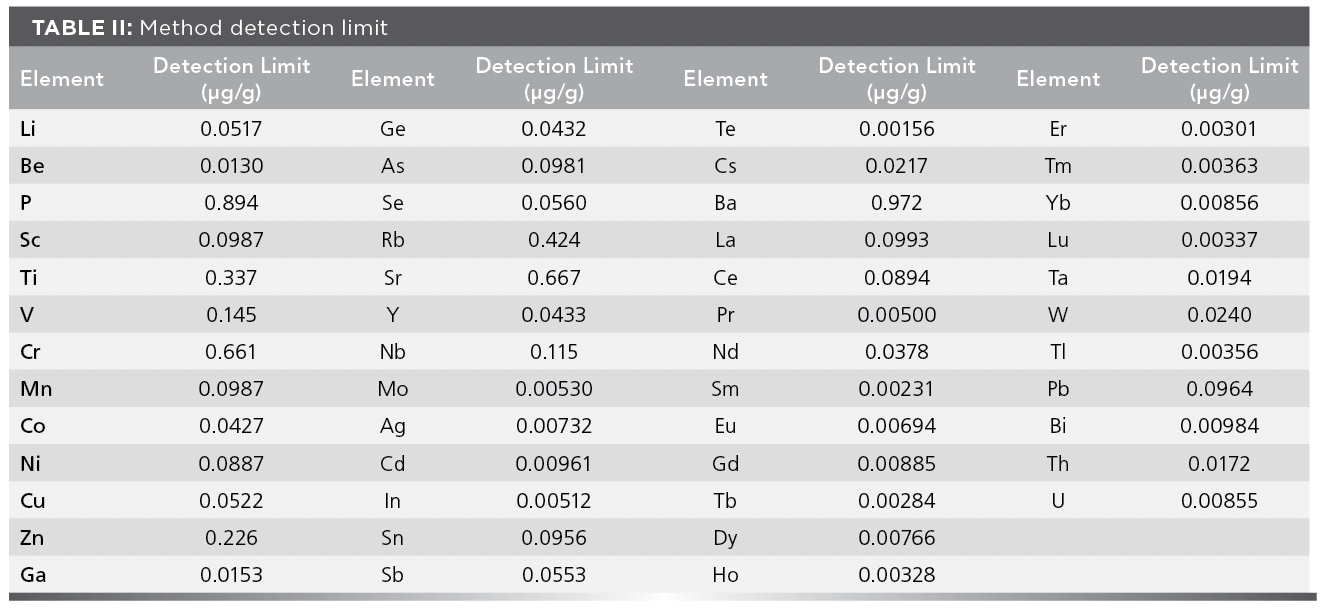
Method Precision
Twelve parallel samples of the national standard reference GSD-20 were weighed according to the experimental method, and the relative standard deviations (RSD) were calculated for all elements. The results showed that the RSD for all elements ranged from 1.1% to 16.4%. It is worth noting that for some elements easily affected by interference, such as V and Cr, and elements with low content, such as Ta, the instrument analysis times should be set to three times, and the integration time should be extended to 30 ms, and the average value of the results should be taken to effectively improve the precision.
Method Accuracy
After processing the national standard substances for soils and stream sediments, GSD-6, GSD-20, GSD-23, GSS-11, GSS-19 and GSS-24, according to the experimental method, the results were compared with the certified values, as shown in Table III. From the results, except for the significant deviation of Se and Sb in GSD-23, the measured values of other elements were basically in agreement with the certified values, indicating the high accuracy of this method.
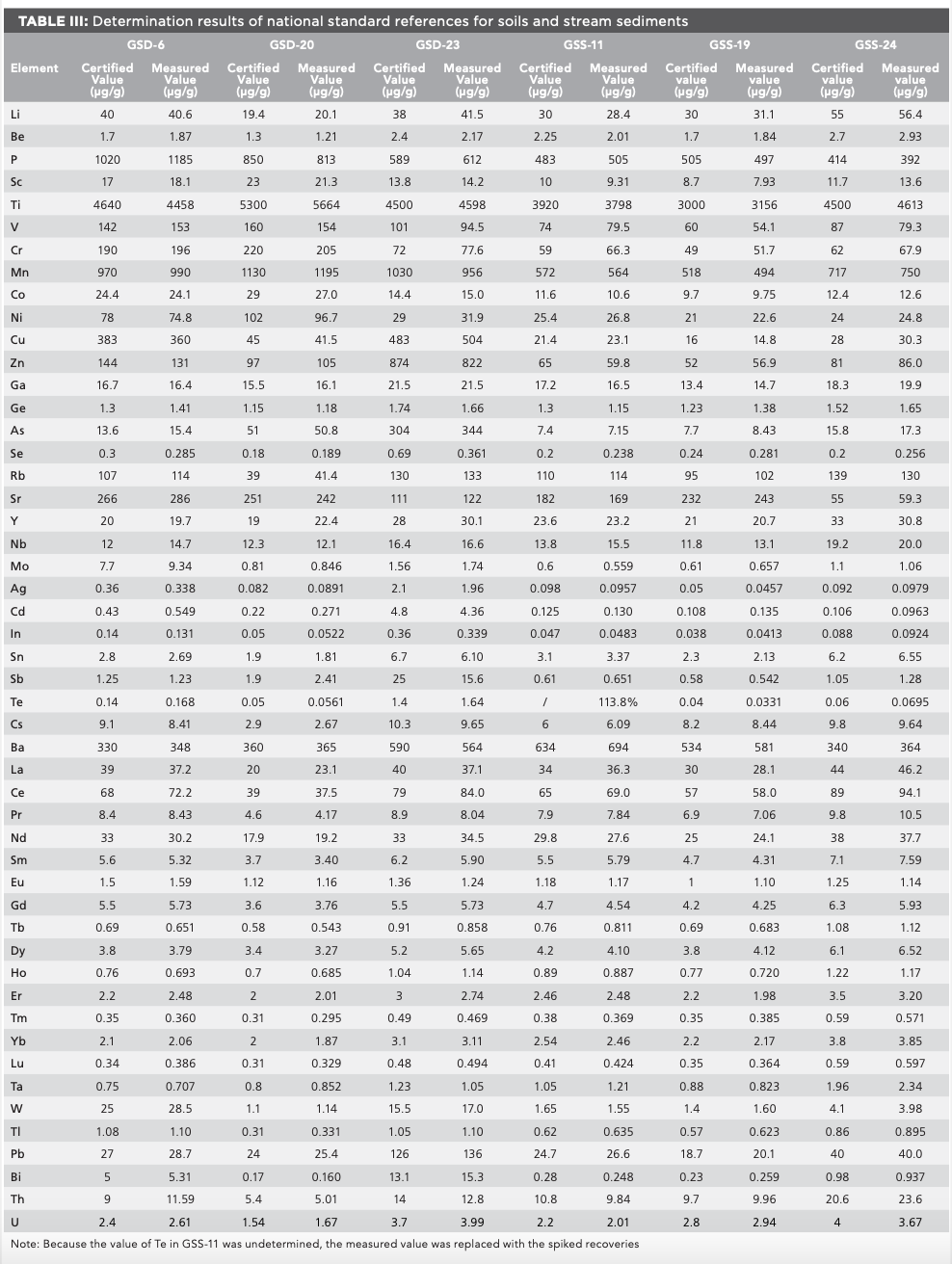
Conclusion
A two-point standard curve was established using national standard references and blank solutions, which is not only convenient but also effective in reducing matrix interferences.
The selected mixed acid for digestion was HNO3+HF+H2SO4, and the redissolving acid was HNO3. The digestion temperature and time were 180 oC and 3 h, respectively.
Compared with open digestion, this method can save more than half of the acid and avoid dust pollution. In addition, for some easily volatile elements such as Se, Te, As, and Ge, they cannot be determined by open digestion, while this method can obtain accurate results. Compared with high-pressure closed digestion and microwave digestion, this method cannot determine Zr and Hf, but the pretreatment efficiency is greatly improved, especially for large-scale detection, which is particularly advantageous.
Acknowledgements
The research project was supported by the geological survey project of China Geological Survey (ZD20220609). We would like to express our sincere gratitude to Chenglong Wei for generously supporting this research.
References
(1) Spiridonov, A. M.; Gnilusha, V. A. Regional to Detailed Geochemical Mapping of the Kariisk Ore District, Eastern Trans-Baikal Region, Russia. J. Geochem. Explor. 1995, 55 (1), 67–74. DOI: 10.1016/0375-6742(95)00029-1
(2) Bölviken, B.; Bogen, J.; Demetriades, A.; et al. Regional Geochemical Mapping of Western Europe Towards the Year 2000. J. Geochem. Explor. 1996, 56 (2), 141–166. DOI: 10.1016/0375-6742(96)00025-8
(3) Elsenbroek, J. H.; Neser, J. A. An Environmental Application of Regional Geochemical Mapping in Understanding Enzootic Geophagia of Calves in the Reivilo Area, South Africa. Environ. Geochem. Health 2002, 24 (1), 159–181. DOI: 10.1023/A:1014247108504
(4) Smith, D. B.; Smith, S. M.; Horton, J. D. History and Evaluation of National-Scale Geochemical Data Sets for the United States. Geosci. Front. 2013, 4 (2), 167–183. DOI: 10.1016/j.gsf.2012.07.002
(5) Birke, M.; Rauch, U.; Stummeyer, J. How Robust are Geochemical Patterns? A Comparison of Low and High Sample Density Geochemical Mapping in Germany. J. Geochem. Explor. 2015, 154 (1), 105–128. DOI: 10.1016/j.gexplo.2014.12.005
(6) Balaram, V.; Subramanyam, K. S. V. Sample Preparation for Geochemical Analysis: Strategies and Significance. Adv. Sample Prep. 2022, 2 (1), 1–18. DOI: 10.1016/j.sampre.2022.100010
(7) Balaram, V. Current and Emerging Analytical Techniques for Geochemical and Geochronological Studies. Geol. J. 2021, 56 (5), 2300–2359. DOI: 10.1002/gj.4005
(8) Oyedotun, T. D. T. X-ray Fluorescence (XRF) in the Investigation of the Composition of Earth Materials: A Review and an Overview. Geol. Ecol. Landsc. 2018, 2 (2), 148–154. DOI: 10.1080/24749508.2018.1452459
(9) Khan, S. R.; Sharma, B.; Chawla, P. A.; Bhatia, R. Inductively Coupled Plasma Optical Emission Spectrometry (ICP-OES): A Powerful Analytical Technique for Elemental Analysis. Food Anal. Methods 2022, 11 (15), 666–688. DOI: 10.1007/s12161-021-02148-4
(10) Sader, J. A.; Ryan, S. Advances in ICP-MS Technology and the Application of Multi-element Geochemistry to Exploration. Geochem. Explor. Environ. Anal. 2020, 20 (2), 167–175. DOI: 10.1144/geochem2019-049
(11) Balaram, V. Current and Emerging Analytical Techniques for Geochemical and Geochronological Studies. Geol. J. 2021, 56 (5), 2300–2359. DOI: 10.1002/gj.4005
(12) Sanchez-Rodas, D.; Corns, W. T.; Chen, B.; Stockwell, P. B. Atomic Fluorescence Spectrometry: A Suitable Detection Technique in Speciation Studies for Arsenic, Selenium, Antimony and Mercury. J. Anal. At. Spectrom. 2010, 25 (7), 933–946. DOI: 10.1039/B917755H
(13) Taylor, V. F.; Toms, A.; Longerich, H. P. Acid Digestion of Geological and Environmental Samples Using Open-Vessel Focused Microwave Digestion. Anal. Bioanal. Chem. 2002, 372 (1), 360–365. DOI: 10.1007/s00216-001-1172-z
(14) Biver, M.; Filella, M. Germanium and Solid Sample Digestion with Aqua Regia: The Nescience of Chemistry Basics and its Sequels. Monatsh. Chem. 2018, 149 (1), 461–465. DOI: 10.1007/s00706-017-2131-5
(15) Yin, X.; Wang, X.; Chen, S.; et al. Trace Element Determination in Sulfur Samples Using a Novel Digestion Bomb Prior to ICP-MS Analysis. At. Spectrosc. 2018, 39 (4), 137–141. DOI: 10.46770/AS.2018.04.001
(16) Ni, W.; Zhang, H.; Mao, X.; Liu, L.; Xiao, F. Determination of Ultra-Trace Osmium and Ruthenium in Geological Samples by ICP-MS Combined with Nickel Sulfide Fire Assay Pre-concentration and Microwave Digestion. Microchem. J. 2019, 150 (11), 1–20. DOI: 10.1016/j.microc.2019.104187
(17) Zhang, W.; Hu, Z. Recent Advances in Sample Preparation Methods for Elemental and Isotopic Analysis of Geological Samples. Spectrochim. Acta B 2019, 160 (10), 1–16. DOI:10.1016/j.sab.2019.105690
(18) Kasar, S.; Murugan, R.; Arae, H.; Aono, T.; Sahoo, S. K. A Microwave Digestion Technique for the Analysis of Rare Earth Elements, Thorium and Uranium in Geochemical Certified Reference Materials and Soils by Inductively Coupled Plasma Mass Spectrometry. Molecules 2020, 25 (21), 1–13. DOI: 10.3390/molecules25215178
(19) Tang, M.; Zhou, C.; Pan, J.; et al. Study on Extraction of Rare Earth Elements from Coal Fly Ash Through Alkali Fusion–Acid lLeaching. Minerals Eng. 2019, 136 (1), 36–42. DOI: 10.1016/j.mineng.2019.01.027
(20) Dassekpo, J. B. M.; Miao, L.; Bai, J.; et al. Phase Dissolution and Improving Properties of Completely Decomposed Granite Through Alkali Fusion Method. Cem. Concr. Compos. 2022, 127 (6), 1–13. DOI: 104407.10.1016/j.cemconcomp.2022.104407
(21) Balaram, V.; Subramanyam, K. S. V. Sample Preparation for Geochemical Analysis: Strategies and Significance. Adv. Sample Prep. 2022, 2 (1), 1–10. DOI: 10.1016/j.sampre.2022.100010
(22) Wysocka, I. Determination of Rare Earth Elements Concentrations in Natural Waters–A Review of ICP-MS Measurement Approaches. Talanta 2021, 221 (1), 1–22. DOI: 10.1016/j.talanta.2020.121636
(23) Santana, A. P. R.; Andrade, D. F.; Guimarães, T. G. S.; et al. Synthesis of Natural Deep Eutectic Solvents Using a Mixture Design for Extraction of Animal and Plant Samples Prior to ICP-MS Analysis. Talanta 2020, 216 (8), 1–9. DOI: 10.1016/j.talanta.2020.120956
(24) Meermann, B.; Nischwitz, V. ICP-MS for the Analysis at the Nanoscale–A Tutorial Review. J. Anal. At. Spectrom. 2018, 33 (9), 1432–1468. DOI: 10.1039/C8JA00037A
(25) Pinto, F. G.; Junior, R. E.; Saint’Pierre, T. D. Sample Preparation for Determination of Rare Earth Elements in Geological Samples by ICP-MS: A Critical Review. Anal. Lett. 2012, 45 (12), 1537–1556. DOI: 10.1080/00032719.2012.677778
(26) Ammann, A. A. Inductively Coupled Plasma Mass Spectrometry (ICP MS): A Versatile Tool. J. Mass Spectrom. 2007, 42 (4), 419–427. DOI: 10.1002/jms.1206
(27) Tan, X.; Wang, Z. General High-Pressure Closed Acidic Decomposition Method of Rock Samples for Trace Element Determination Using Inductively Coupled Plasma Mass Spectrometry. J. Anal. Chem. 2020, 75 (10), 1295-1303. DOI: 10.1134/S1061934820100147
(28) Wheal, M. S.; Fowles, T. O.; Palmer, L. T. A Cost-Effective Acid Digestion Method Using Closed Polypropylene Tubes for Inductively Coupled Plasma Optical Emission Spectrometry (ICP-OES) Analysis of Plant Essential Elements. Anal. Meth. 2011, 3 (12), 2854–2863. DOI: 10.1039/C1AY05430A
(29) Hansen, T. H.; Laursen, K .H.; Persson, D. P.; et al. Micro-Scaled High-Throughput Digestion of Plant Tissue Samples for Multi-Elemental Analysis. Plant Methods 2009, 5 (1), 1–11. DOI: 10.1186/1746-4811-5-12
(30) Wang, J. H.; Li, Z. H.; Yang, F.; Yang, X. J.; Huang, J. S. Simultaneous Determination of 48 Elements in Marine Sediments by ICP-MS with Lithium Metaborate Fusion. Rock Miner. Anal. 2021, 40 (2), 306–315. DOI: 10.15898/j.cnki.11-2131/td.202006050085 shu
(31) Huang, Y.; Lum, J. T. S.; Leung, K. S. Y. Single Particle ICP-MS Combined with Internal Standardization for Accurate Characterization of Polydisperse Nanoparticles in Complex Matrices. J. Anal. At. Spectrom. 2020, 35 (10), 2148–2155. DOI: 10.1039/D0JA00180E
(32) D’Ilio, S.; Violante, N.; Majorani, C.; Petrucci, F. Dynamic Reaction Cell ICP-MS for Determination of Total As, Cr, Se and V in Complex Matrices: Still a Challenge? A Review. Anal. Chim. Acta. 2011, 698 (1), 6-13. DOI: 10.1016/j.aca.2011.04.052
Jiahan Wang, Kai Tang, Wenguang Jiao, and Dacheng Wang are with the Haikou Marine Geological Survey Center of China Geological Survey, in Haikou, China. Direct correspondence to: wjhazxy@qq.com ●
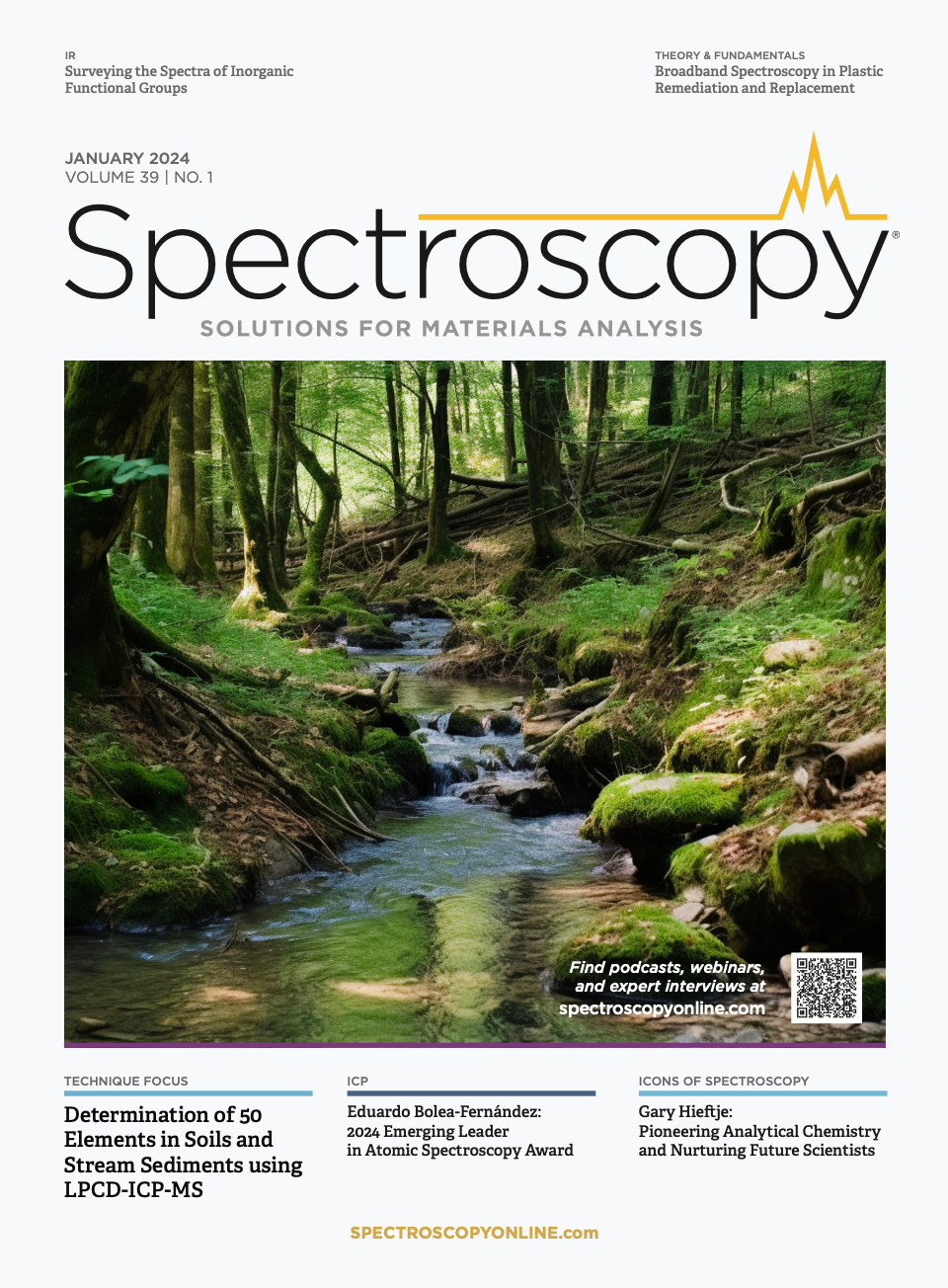
Geographical Traceability of Millet by Mid-Infrared Spectroscopy and Feature Extraction
February 13th 2025The study developed an effective mid-infrared spectroscopic identification model, combining principal component analysis (PCA) and support vector machine (SVM), to accurately determine the geographical origin of five types of millet with a recognition accuracy of up to 99.2% for the training set and 98.3% for the prediction set.